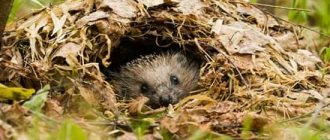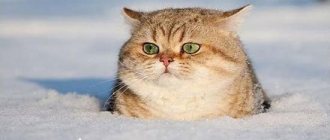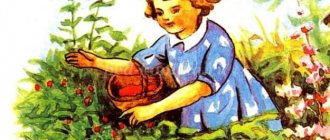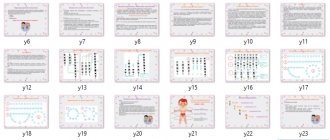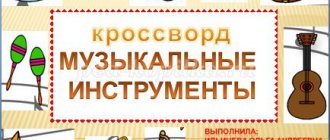Summary of the lesson “Preparing wild animals for winter”
Target:
Formation of ideas about the life of wild animals in the autumn-winter period.
Objectives:
1. To consolidate children’s knowledge of wild animals;
2. Introduce children to the names of wintering places for animals (burrows, dens, huts); 3. Consolidate knowledge of animal diet; 4. To promote the development of a desire to care for and help animals during the winter; 5. Develop children's creative abilities. Additional material: presentation “Preparing animals for winter”, A4 sheets, pencils, markers, paints (children’s choice).
Progress of the lesson:
Educator:
Hello guys!
What a wonderful day today! The leaves are quietly falling outside, the sun, although not so warm, still shines brightly. Autumn is an amazing time. You agree with me? (children's answers) Please tell me what happens to nature and animals in the fall? (children's answers) You're right guys, all nature is preparing for winter at this time. And today, we will talk about how animals prepare for winter, and the fairy Fauna will help us with this. Do you guys know that the very name of this fairy means the living world. So, let's begin! (1 slide) Educator:
Winter will begin very soon - the hardest time of the year for animals.
They freeze, even catch a cold, and cannot get food from under the snow. Some animals change their coats to a warmer, winter coat, and some even hibernate. (2 slide) Educator:
Rodents (mice, chipmunks, hamsters) are the very first to begin preparing for winter.
They begin their preparation in the summer. They find a variety of seeds and nuts and collect them in their burrow. These reserves help them survive the cold in winter without going outside. Since during cold weather, rodents almost always sleep, interrupting their sleep only to eat. (3rd slide) Educator:
Who are these guys?
(children's answers) That's right, it's a hedgehog. Hedgehogs accumulate fat in winter, and on clear autumn days they prepare warm, cozy nests for themselves. Yes, yes, that’s what they call a hedgehog’s house for the winter. Night and day they carry dry leaves and soft moss to their house. The hedgehog hibernates for up to 6 months. In winter, hedgehogs do not eat; they sleep curled up in their house under a thick layer of snow, like under a warm blanket. (4 slide) Educator:
Now let's talk about bears.
What is the name of his house? (children's answers) That's right, a den. Bears spend a long time and carefully preparing their home. They look for caves, ditches, where they carry leaves, moss, twigs, and on top they make a soft mattress from spruce branches. When snow falls, it closes the bear in his house and it remains warm there all winter. Bears do not store food, but in the fall they actively feed on fish and nuts in order to accumulate fat for the winter. In fact, the bear does not sleep, but simply dozes, and if necessary, it can leave the den. It is in winter that bears give birth to cubs. Guys, have you heard that bears suck their paws? (children's answers) Do you think this is true? (children's answers) This is true, but he does this because the skin on his paws itches and the bear thus licks off the keratinized part of the skin. Educator:
Now, let’s have a little rest with you.
(Physical school is being held) Physical training “Hares”
The hares got up early in the morning and played merrily in the forest.
Jump-jump-jump along the paths! Who is not used to charging? (Jumping in place)
Here is a fox walking through the forest.
Who's jumping there, I wonder? (Walking in place)
To answer the question, the little fox pulls his nose.
(Stretching - arms forward)
But the bunnies jump quickly.
How could it be otherwise? (Jumping in place)
Training helps!
And the bunnies run away. (Running in place)
Here is a hungry fox
(Walking in place)
Looking sadly at the heavens.
(Stretching - arms up)
Sighs heavily.
(Deep inhalation and exhalation)
Sits down and rests.
(Children sit at the tables) Educator:
We had a wonderful rest and warmed up, just like real bunnies.
Let's continue our conversation about preparing animals for winter. Guess the riddle: From branch to branch, fast as a ball, a red-haired circus performer gallops through the forest. Who is this? (children's answers) (5 slide) That's right guys, it's a squirrel! Squirrels sleep in winter only in very severe frosts; the rest of the time they lead the same active lifestyle. And the squirrel needs significant reserves. In autumn they hide nuts and acorns in leaves, soil and hollows. They also store mushrooms, but in a special way: they string them on branches. They build their nest on tall spruce or pine trees. In the hollow there is soft grass, moss, balls of wool. (6 slide) Educator:
Beavers also do not hibernate, but they prepare for winter very seriously.
They live in large families and build their houses (huts) on the banks of reservoirs. They make the entrance to the hut underwater. And who knows why they do this? (children's answers) Underwater, no predator will penetrate their house. For the winter, beavers make provisions: twigs from trees and plant roots that they find in the water. It’s warm inside the beavers’ hut, and even in the cold winter the temperature is above zero. (7 slide) Educator:
You and I know that in the winter, hares change the color of their fur coat to white so as not to be so noticeable.
Hares feed on bark and small twigs of aspen, willow, and birch. In winter, a fallen tree can become a real dining room for a hare, where the animals come every day until they gnaw off all the bark. Hares do not have permanent housing; on cold days they hide under snow-covered bushes. (8 slide) Educator:
By the fall the fox has already raised her cubs and is not sitting in the hole.
But if danger arises, it hides there. Foxes make their holes at the edge of the forest on a hill so that they can see the forest from all sides. It is not for nothing that they say that the fox is cunning: it does not immediately run to the hole, it first makes a loop to confuse its tracks, and only then hides. The fox runs well in the snow and hunts all year round, so it doesn’t need supplies. (Slide 9) Educator:
And this is another predator - a wolf.
Wolves are very dangerous predators. In winter, they gather in flocks to make it easier to hunt. Foxes, wolves and other predators feed on small animals such as hares, mice, and hamsters. They can also go hungry for a long time, and during severe frosts they hide in the snow. It is interesting that predators do not include healthy animals in their unique menu, simply because they cannot catch up with them. That’s why predators are also called forest orderlies, because they kill sick animals that can be contagious. Educator:
Guys, what do you think, how can we help animals in such a harsh time as winter?
(children's reasoning) You are right, you can leave food for them in special places. This is exactly what many people do. (10 slide) Now, let's draw what we learned about today. You can draw any animal in winter or how you help them survive the winter. (children make drawings) Educator:
Well done guys, you made wonderful drawings. Now let's remember what you learned today? (children's answers) You really learned a lot about preparing wild animals for winter and realized that they can and should be helped. And we will display your wonderful works at our stand. Thank you for your attention!
